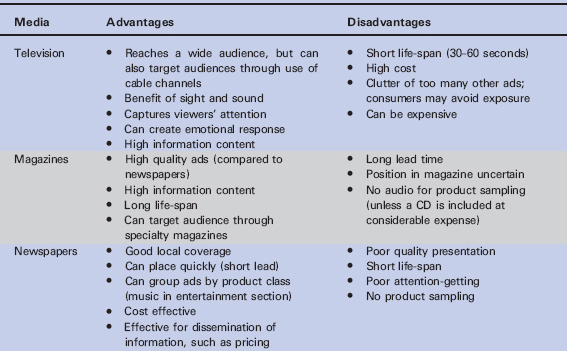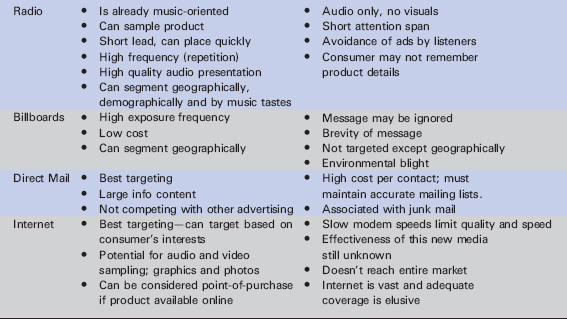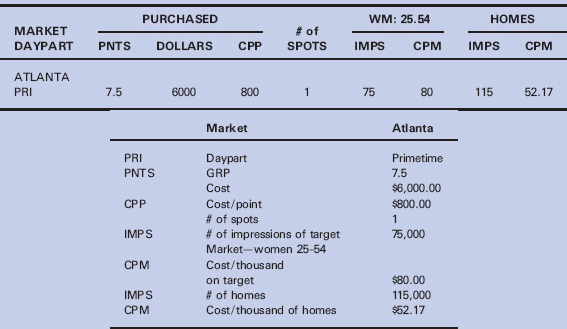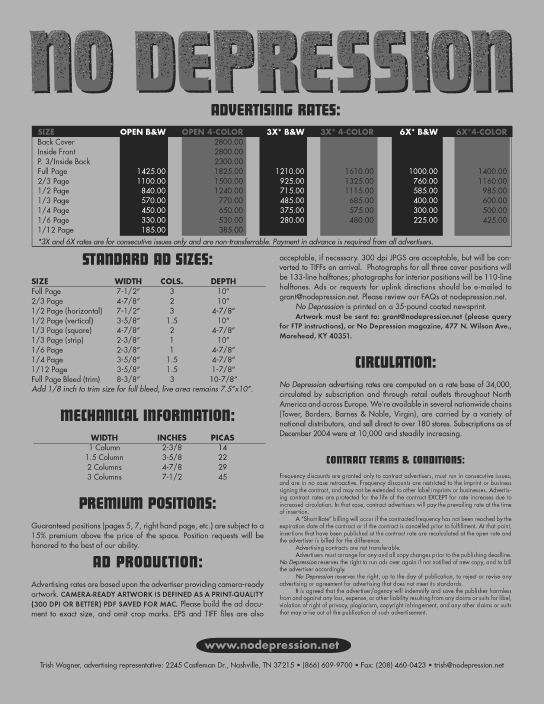| 10 | Advertising in the Recording Industry |
Advertising is a form of marketing communication. It is described by Bovée and Arens (1986) as “the nonpersonal communication of information usually paid for and usually persuasive in nature about products, services, or ideas by identified sponsors through the various media.” The fact that advertising is paid for and persuasive (i.e., the seller controls the content and message) separates it from other forms of mass mediated communication such as publicity, news and features. Advertisements are usually directed toward a particular market segment, and that dictates which media and which vehicles are chosen to present the message. A medium refers to a class of communication carriers such as television, newspapers, magazines, outdoor, and so forth. A vehicle is a particular carrier within the group, such as Rolling Stone magazine or MTV network. Advertisers determine where to place their advertising budget based on the likelihood that the advertisements will create enough of an increase in sales to justify their expense. Advertisers must be familiar with their market and consumers’ media consumption habits in order to be successful in reaching their customers as effectively as possible.
The most basic market segments for advertising are: (1) consumers, and (2) trade, which are people within the industry that make decisions affecting the success of your marketing efforts. The first market segment (consumers) is targeted through radio, television, billboards, direct mail, magazines, newspapers and the Internet. Consumer advertising is directed toward potential buyers to create a “pull” marketing effect (see Chapter 1). The second target market (the trade) consists of wholesalers, retailers, and other people who may be influenced by the advertisements and respond in a way that is favorable for the marketing goals. This creates a “push”marketing effect (again, see Chapter 1). In the recording industry, this would include radio program directors that may be influenced by an advertisement in Radio & Records to more favorably consider a particular advertised song for inclusion in the station’s weekly playlist. Trade advertising is usually done through direct mail and through trade publications (usually magazines) aimed at people who work in the industry. Trade advertising is not common through television, radio and newspapers because they are too general in nature—not targeted enough to effectively reach the industry. Online publications for trade and consumers are becoming a factor in record label advertising.
Comparison of media options for advertising
The most complex issue facing advertisers involves decisions of where to place advertising. The expansion of media has increased the options and complicated the decision. The following chart in Table 10.1 represents a basic understanding of the advantages and disadvantages of the various media options.
Table 10.1 A comparison of media


Determining costs and effectiveness
Advertisers have many choices when it comes to how to spend the advertising budget to maximize effectiveness, and the options keep increasing. In the 1950s and 1960s, television and magazines were not as fragmented as they are today, and content was more general in nature. Media fragmentation is defined as the division of mass media into niche vehicles through specialization of content and segmentation of audiences. In the 1960s, advertisers sought to reach particular groups of potential customers, rather than paying for advertising in general media vehicles that would be wasted on viewers who were not interested in their product.
Magazines became the first medium to go through fragmentation. The popularity of general appeal magazines such as Life, Look and Saturday Evening Post gave way to the rise in specialty magazines that dealt with everything from fitness to alternative music. Advertisers would rather pay for ads in the particular publications that reach their market than pay the more expensive rates to reach the general population. Fragmentation spread to television with the expansion of cable TV. The Internet offers the ultimate in fragmented and specialized content or what is now being considered as “media personalization.” As a result of this, advertisers can now reach people who are more likely to be potential consumers of the particular products being advertised.
Media planning involves the decisions made in determining in which media to place advertisements. It consists of a series of decisions made to answer the following questions (Sissors, J., and Bumba, L., 1994):
1. How many potential consumers do I need to reach?
2. In what medium (or media) should I place ads?
3. When and how often should these ads run?
4. What vehicles and in which markets should they run?
5. What choices are most cost-effective?
The development of the media plan must incorporate the following considerations:
1. Marketing objectives – What are the goals of the entire marketing plan? To inform the buyer? To motivate the buyer? To change attitudes? To promote repeat purchases? To reinforce a previous purchase? To create a buzz? To emphasize price or value? To create sampling opportunities?
2. Characteristics of the product – Some products are more suitable for advertising in one medium over another. For example, perfume samples work well in magazines but not on radio. For music, audio is important but so are visuals.
3. Pricing strategy – The high costs associated with some media makes media buys impractical.
4. Channels of distribution – Media buys should be limited to areas where the product is available for sale and where they would support retailers.
5. Promotion plans – This involves determining the relative amount of effort needed for advertising, compared to other marketing aspects, and to complement and support them (Dunn, S. et al., 1990).
How advertising effectiveness is measured
The basic structure of measuring advertising effectiveness starts with information on reach, frequency, gross impressions, gross rating points (GRP), and cost per thousand (CPM). Reach is the number of different persons or households exposed to a particular media vehicle during the specified time period. Frequency is the number of times during that period that a prospect or a portion of the population is exposed to the message.
![]()
The concept used to measure these two notions together is gross rating points. Gross rating points (GRP) is a measure of the total weight of advertising that derives from a particular media buy; reach (expressed as a percentage of the market) times average frequency. It is the sum of the ratings for the individual announcements or programs. In television, GRP is the total weight of a media schedule against TV households. For example, a weekly schedule of five commercials with an average household rating of 20 would yield 100 GRPs.
GRP = reach × average frequency
Gross impressions (GI) are a measure of total media exposure. It is the sum of audiences of all vehicles used in a media plan. The number represents the message weight of a media plan. The purpose of GI analysis is to get a quick look at the total audience size of one or more media (Scissors, J. and Bumba, L., 1994). It is good for comparing with other media plans that may include a different group of media vehicles. GI can be calculated by adding the target audience sizes (audience size × number of exposures) delivered by each media vehicle in the plan.
When determining the effectiveness of an advertising plan, the costs must be factored in. This is done by determining the cost per rating point (for electronic media), and cost per thousand (a more general measure). Cost per rating point (CPP) is defined as determining what media programs are most cost-effective by dividing the cost of advertising by the show’s expected rating.
CPP = Cost of ad schedule/GRP
Cost per thousand (CPM) is a term describing the cost of reaching 1,000 people in the medium’s audience—the cost of delivering 1,000 gross impressions. It is used in comparing or evaluating the cost efficiency of various media vehicles. The formula varies depending on the media.
Table 10.1 A comparison of media

All other things being equal, you would expect advertisers to look for the lowest cost-per-thousand medium as being the most efficient. But this is seldom the case. Specialized products for narrowly targeted markets may require more scrutiny of each vehicle’s ability to reach the target market and the effectiveness of the type of message being delivered. For example, a specialty music magazine such as Down Beat, designed to reach jazz fans, may cost more per each thousand people reached than local newspapers, but those who are reached may be more inclined to purchase a new jazz recording. Also, labels want to take advantage of the sampling capabilities of radio, television and the Internet, rather than rely on print media to sell music.
The role of advertising in marketing recorded music
Advertising is crucial for marketing recorded music just as it is for other products. The primary advertising vehicle in the recording industry is local print, done in conjunction with retail stores to promote pricing of new titles, and is referred to as co-op advertising. But the record industry also relies on magazine, radio, television, outdoor and Internet advertising. The impact of advertising is not easy to measure because much of its effect is cumulative or in conjunction with other promotional events such as live performances and radio airplay. SoundScan has improved the ability to judge the impact of advertising, but since marketing does not occur in a vacuum, the relative contribution of advertising to sales success remains somewhat of a mystery.
Advertising campaigns usually reflect the imaging of an artist’s release. Consistency of artist photos, theme, and even the font of the text create indelible impressions that help consumers make the connection between the advertisement and the actual purchase of the release. Some ads may use related photos to the actual cover art of the CD, but where applicable, the actual CD cover will also be included.
The recording industry uses trade publication advertising to set-up the release of a single to radio by advertising in publications often read by the radio industry, including Radio & Records, Billboard, HITS magazine, Friday Morning Quarterback, and The Album Network. Advertising in Billboard also reaches the retail industry and may influence retail buyers. Labels may also use direct mail flyers sent to retail accounts to help promote album releases.
These flyers may sometimes be sent through the distributors or one-stops. Postcard advertisements may also be sent to radio stations to generate interest in a single.
Coordinating with the publicity department
Any media campaign should be designed in conjunction with the publicity department. A coordinated media campaign is necessary because the vehicles targeted for advertising are the same vehicles targeted for publicity and some synergy may occur. For example, placing an ad in a particular publication may increase the likelihood of getting some editorial coverage. Or at least, if it has been determined that the vehicle reaches the targeted market, those consumers will be receptive to the editorial content of the publication, as well as the advertisement content. For example, if you wanted to sell hiking shoes, you would probably select a hiking, camping or backpacking magazine for your advertising, but you are also more likely to get a product review in those publications than in a parenting or sewing magazine.
Co-op advertising
Co-op advertising or cooperative advertising is generally defined as the joint promotion effort of two or more parties in the selling chain. It offers the potential for synergy between the two parties and is quite common in the recording industry. More specifically, co-op advertising is usually run by a local advertiser (retailer) in conjunction with a national advertiser (manufacturer). The national advertiser usually provides the copy and shares (or bears) the cost with the local retailer. Record labels team up with retail chains to create co-op advertising programs.
Co-op advertising offers a number of advantages to the manufacturer. It gains the retailer’s support and endorsement, improves the relationship between the manufacturer and the retailer, helps get more products in the store and utilizes the retailer’s knowledge of the local market.
Cooperative advertising programs must follow the guidelines and legal statues as monitored by the Federal Trade Commission to ensure fairness in trade practices. The Robinson-Patman Act of 1936 forbids price and payment (including payment for advertising) discrimination between suppliers and retailers. In other words, participating in a co-op promotion amounts to the retailer receiving a discount on goods purchased from the manufacturer. The discount comes in the form of a “rebate” paid for providing local advertisements.
If the plan is offered to one retail chain over another, it amounts to discriminatory promotional allowances in violation of the Robinson-Patman Act.
Although co-op advertising is usually targeted to consumers of a specific product, the ad dollars exchanged for the exposure will most likely gain added product placement with the retailer. For example, if a mini-album cover of a new release is placed in a retailer’s Sunday circular, readers of the insert will then know about its release, what is looks like, the price, etc. But for placing the mini in the ad, the record label gains added exposure in-store as well, such as placement of the CD on the bestseller endcap, as well as extra product in the bin.
Co-op advertising can be perceived as a double-edged sword, meaning that consumers learn of new releases while the label gains additional exposure in the store. But understand that co-op advertising is usually part of the equation during the initial buy as well as continual support of the release through its lifecycle. Often times, co-op ad dollars offset margin, since a co-op advertising vehicles often feature a release at “sale” price. The retailer can afford to discount the consumer price of the release since co-op ad dollars are aiding the profitability of each unit sold. (Co-op advertising is discussed in greater detail in the retail chapter.)
Consumer advertising: the media buy
When considering a media buy, labels consider many factors:
![]() Budget
Budget
![]() Target market
Target market
![]() Media
Media
![]() Timing
Timing
![]() Partners
Partners
![]() Artist Relations
Artist Relations
Advertising budgets
Determining the budget sets the parameters and scope of any advertising campaign. Recognizing financial limitations can assist in creating a media buy that is the “best bang for the buck.” Using the projected sales of the record plus a profit & loss analysis, labels can create a budget based on forecasted sales. To calculate a ballpark ad budget, published rate cards of advertising costs can be collected to assist in the budgeting process. The chapter regarding the profit & loss statement of a project discusses at length the implication of marketing dollars and advertising.
Focusing on a target market increases the effectiveness of a media buy. Most products have a specific consumer to whom companies aim their promotions. This focus determines the type of media that is purchased. For example, many products created for parents are targeted in women’s lifestyle magazines as well as daytime television, with research validating that stay-at-home mothers are consuming these media. When purchasing media, most consultants look at targets demographically and when these demographics are engaging the media. Women ages 25–54, and men ages 18–24 are examples of profiling the target market. Attention to dayparts when the target is engaged is also relevant. Specifying a particular time of day to increase chances of hitting the target is strategic in creating an effective advertising buy. Evaluating the media by target enables an advertising buyer to focus the purchase. Ratings of electronic media outlets are determined by Arbitron and Nielsen. As discussed in the chapter “How Radio Works,” media outlets operate their businesses to attract a certain consumer, so that they can create revenue via the sale of advertising.
Deciding which media to advertise through can be an agonizing process. Print advertising historically has the lowest cost per thousand (CPM) considering its wide readership. Newspaper advertising is known as the shotgun approach—a shotgun uses “shot” instead of a bullet. “Shot” will scatter and possibly hit the target, but will likely hit other areas too. A newspaper is consumed by many demographics, a small portion of which may be the target. Is this the best “bang for the advertising buck?” Depending on the product, it may be most effective. For music, newspaper advertising has an important role in alerting music buyers as to new releases. The Sunday circulars of various retailers often feature new releases that are streeting on the upcoming Tuesday. But some record label executives question, “Can a consumer hear a print ad?”
To hear the product, consumers would need to listen to radio, watch television, or engage the Internet to be able to “test drive” the product through advertising. Radio and television usually incur a higher CPM, but the audience is more concentrated, meaning that an advertisement on these outlets has a higher probability of hitting the target.
![]() A Figure 10.1 No Depression rate card (Source: No Depression)
A Figure 10.1 No Depression rate card (Source: No Depression)
When to purchase the advertising “run” is a critical decision. Most advertising outlets have “lead” times in which they need to prepare for the actual advertisement. Note the above rate card information from “No Depression.” To place a print ad for the January/February 2006 magazine, artwork has to be delivered to the magazine no later than November 17, 2005. Radio and television lead time tend to be shorter, since their advertising activities often occur in “real-time.” But what does need time is the creation of the actual advertising spot. Both radio and television advertising require pre-recorded “spots” in which to air. Creation of these spots includes production issues such as musical content, voice-over ad copy, and in the case of television, visual images as well. Some labels will pre-produce spots with an eye towards the need to make a quick advertising decision.
In studying lifecycles of releases, most labels recognize the urgency of front-loading the advertising, since the bulk of sales occur early in the release of a record. Often, labels work diligently to alert consumers of a new release in order to increase the sales response at street date. But on occasion, a record may have a 2nd or 3rd single that is the reactionary song, giving the label an incentive to fuel the sales fire by generating an advertising buy.
Some advertising buys have a dual-purpose. Clearly, the primary objective is to alert consumers as to the availability of a release. But in many cases, the advertising purchase enables the label to leverage additional exposure by building in a promotional partner. When purchasing ad time, a record label may consider approaching a retailer as the destination store tag, such as “Available now at Tower Records.” This activity would include logo placement of the retailer on both print and television advertisements. In turn, the retailer may purchase more records of the specified artist as well as prominently placing the release in stores, anticipating an increase in sales.
In an ideal situation, labels and their artists should look at their business relationship as a partnership. The artist delivers the product that the record label is to market and sell. An artist should expect from its label a level of commitment and promotional activity to give the release the best possible shot at success. Many efforts are put forth by record labels to ensure success, and one of these activities is advertising. An artist, with his or her manager, should review the promotional efforts being created and executed by the label, just as the label reviews the music of the artist.
Table 10.3 Sample TV advertising buy

This television advertising buy was bolstered by additional ad exposure at radio. These time buys were during the week leading up to the CMA Awards Show.
Table 10.4 Radio buy

The combined advertising gross rating point (GRP) for the Atlanta market was 82.5. Although $15,000 was spent at radio, the CPM was dramatically lower than at television. Additionally, many more women aged 25–54 were reached because of the focused advertising that radio and its specific targeted demographics can deliver. Generally, radio advertising does not include gross impressions of homes.
With any budget, the greater the GRP, the better the advertising “bang for the buck.” An actual advertising campaign would be comprehensive in attempting to reach the target market while maintaining a budget. To do so, buys at many outlets would be secured. The optimal equation to increase the GRP includes varying the combinations of media, dayparts, and number of spots. Depending on the agenda as well as the budget, all advertising should help increase visibility and sales of a specific artist or project.
Cooperative advertising (co-op) – An advertisement where the cost is shared by the manufacturer of the product and the local retail outlet.
Cost per thousand (CPM) – A dollar comparison that shows the relative cost of various media or vehicles; the figure indicates the dollar cost of advertising exposure to a thousand households or individuals.
Dayparts – Specific segments of the broadcast day; for example, midday, morning drive time, afternoon drive time, late night.
Frequency – the number of times the target audience will be exposed to a message.
Gross impressions – The total number of advertising impressions made during a schedule of commercials. GIs are calculated by multiplying the average persons reached in a specific time period by the number of spots in that period of time.
Gross rating point (GRP) – In broadcasting/cable, it means the size of the audience during two or more dayparts. GRPs are determined by multiplying the specific rating by the number of spots in that time period.
Media fragmentation – The division of mass media into niche vehicles through specialization of content and segmentation of audiences.
Media planning – Determining the proper use of advertising media to fulfill the marketing and promotional objectives for a specific product or advertiser.
Medium – a class of communication carriers such as television, newspapers, magazines, outdoor, and so on.
Rating – In TV, the percentage of households in a market that are viewing a station divided by the total number of households with TV in that market. In radio, the total number of people who are listening to a station divided by the total number of people in the market.
Rating point (a rating of 1%) – 1% of the potential audience; the sum of the ratings of multiple advertising insertions; for example, two advertisements with a rating of 10% each will total 20 rating points.
Reach – The total audience that a medium actually reaches; the size of the audience with which a vehicle communicates; the total number of people in an advertising media audience; the total percentage of the target group that is actually covered by an advertising campaign.
Trade advertising – Advertising aimed specifically for retailers and media gatekeepers.
Trade publication – A specialized publication for a specific profession, trade, or industry; another term for some business publications.
Vehicle – A particular carrier within the group, such as Rolling Stone magazine or MTV network.
Bibliography
Bovée, C. L., and Arens, W. F. (1986). Contemporary Advertising (2nd edition), Homewood: Irwin.
Dunn, S. et al. (1990). Advertising: Its Role in Modern Marketing (7th edition), Orlando: The Dreyden Press.
Sissors, J., and Bumba, L. (1994). Advertising Media Planning (4th edition), Lincolnwood: NTC Business Books.

